Abstract
In a prospective, community-based study of 675 consecutive patients with a first-ever stroke, of whom over 90% had computed tomography (CT) and/or necropsy examinations, 129 deaths occurred within 30 days of the onset of symptoms, a case fatality rate (CFR) of 19%. The 30 day CFR for patients with cerebral infarction was 10% (57 of 545, for primary intracerebral haemorrhage 52% (34 of 66), for subarachnoid haemorrhage 45% (15 of 33) and for those of uncertain pathological type 74% (23 of 31). The CFR for patients who had been functionally dependent pre-stroke was 33% compared with 17% for those who had been independent pre-stroke. The age-adjusted relative risk of death for patients who had been functionally dependent pre-stroke was not significantly greater (1.8, 95% confidence interval 0 to 4.3). There was a significant trend for CFR to increase with age (Chi square for trend = 4.0, p less than 0.05). This relationship was found in those patients who had been functionally independent prestroke (Chi square for trend = 7.9, p less than 0.005) but not in those who had been dependent pre-stroke (Chi square for trend = 0.5, NS). The pattern of increasing CFR with increasing age amongst those who had been independent prestroke was seen particularly in patients with cerebral infarction (Chi square for trend = 8.6, p less than 0.005). The age-adjusted relative risk of death for patients with cerebral infarction who had been functionally dependent pre-stroke was 2.2 (95% confidence interval 1.2 to 4.1). Fifty three percent of all deaths within 30 days of stroke were due to the direct neurological sequelae of the stroke. Patients with primary intracerebral or subarachnoid haemorrhages were significantly more likely to die in this way than those with cerebral infarction (relative risk 4.1; 95% confidence interval 3.4-4.9) and 56% of such deaths occurred within 72 hours of onset. In patients with cerebral infarction, 51% of deaths were due to complications of immobility (for example, pneumonia, pulmonary embolism) and these were more likely to occur after the first week. These findings have implications for clinical practice and the planning of clinical trials.
Full text
PDF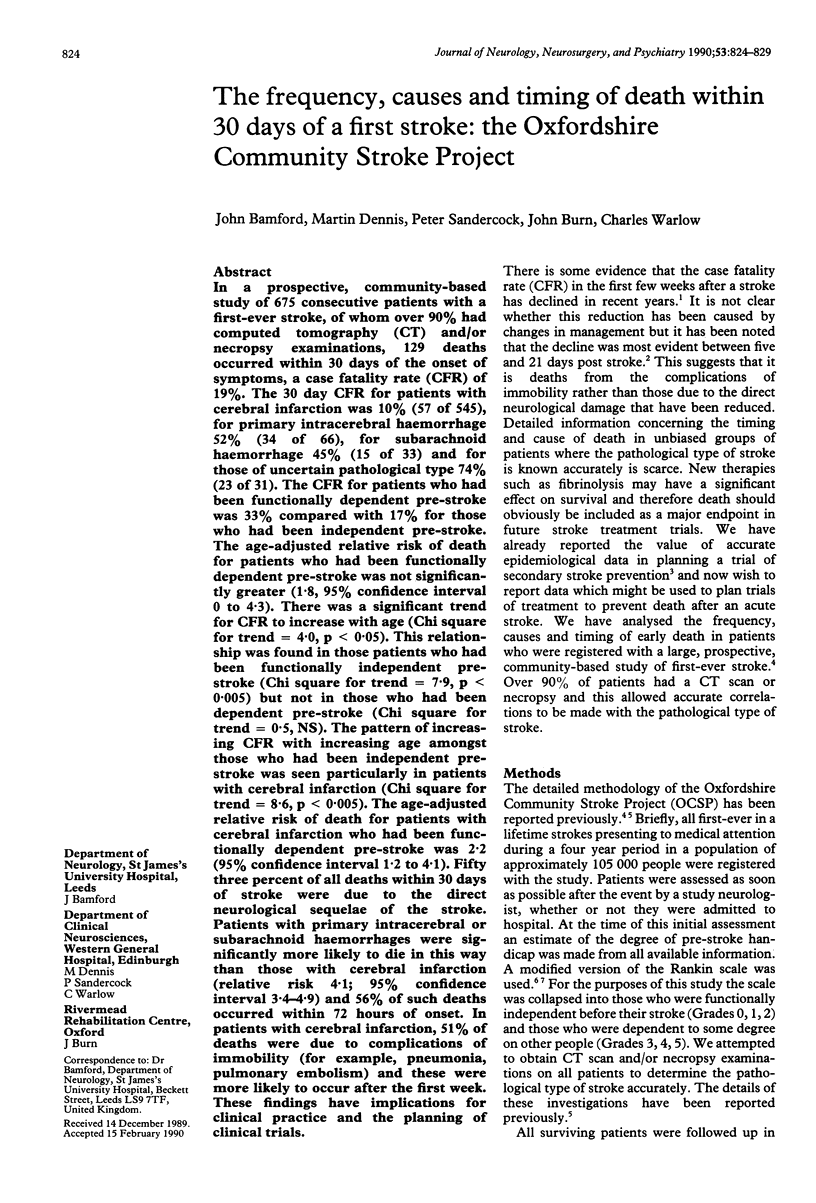
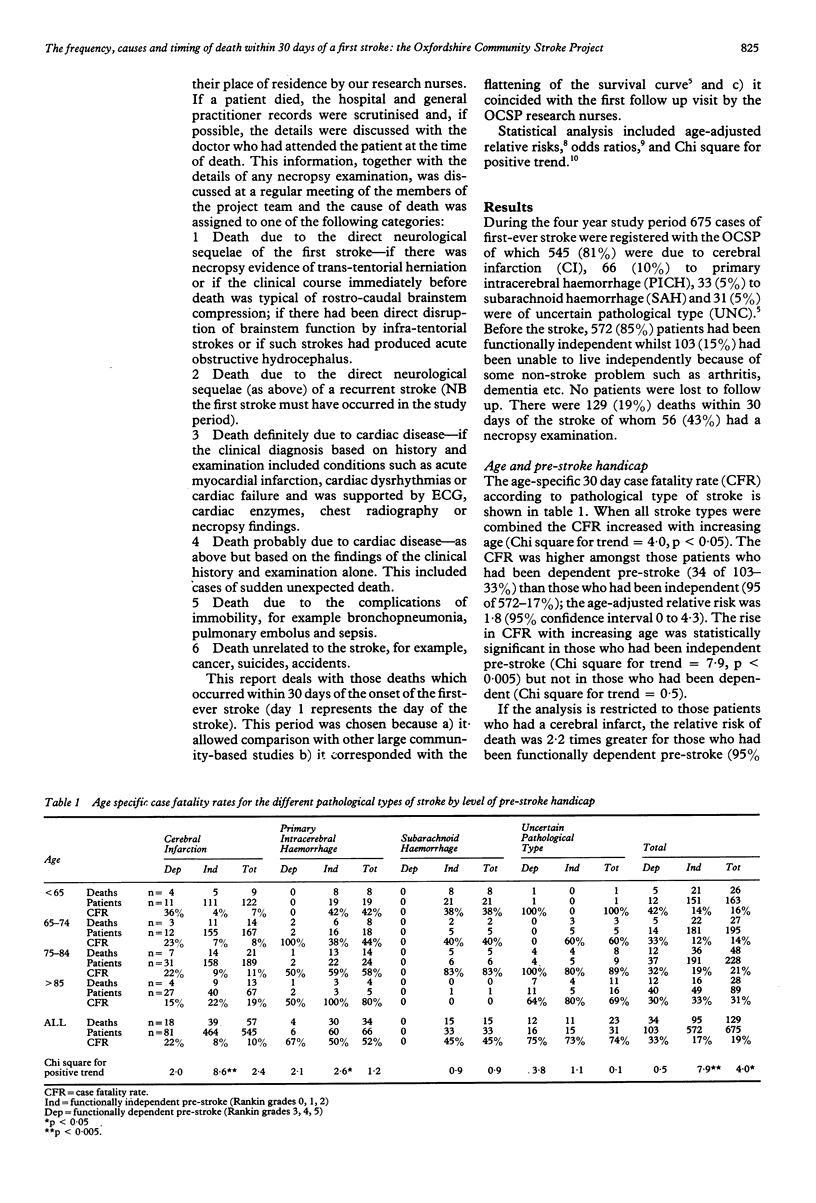
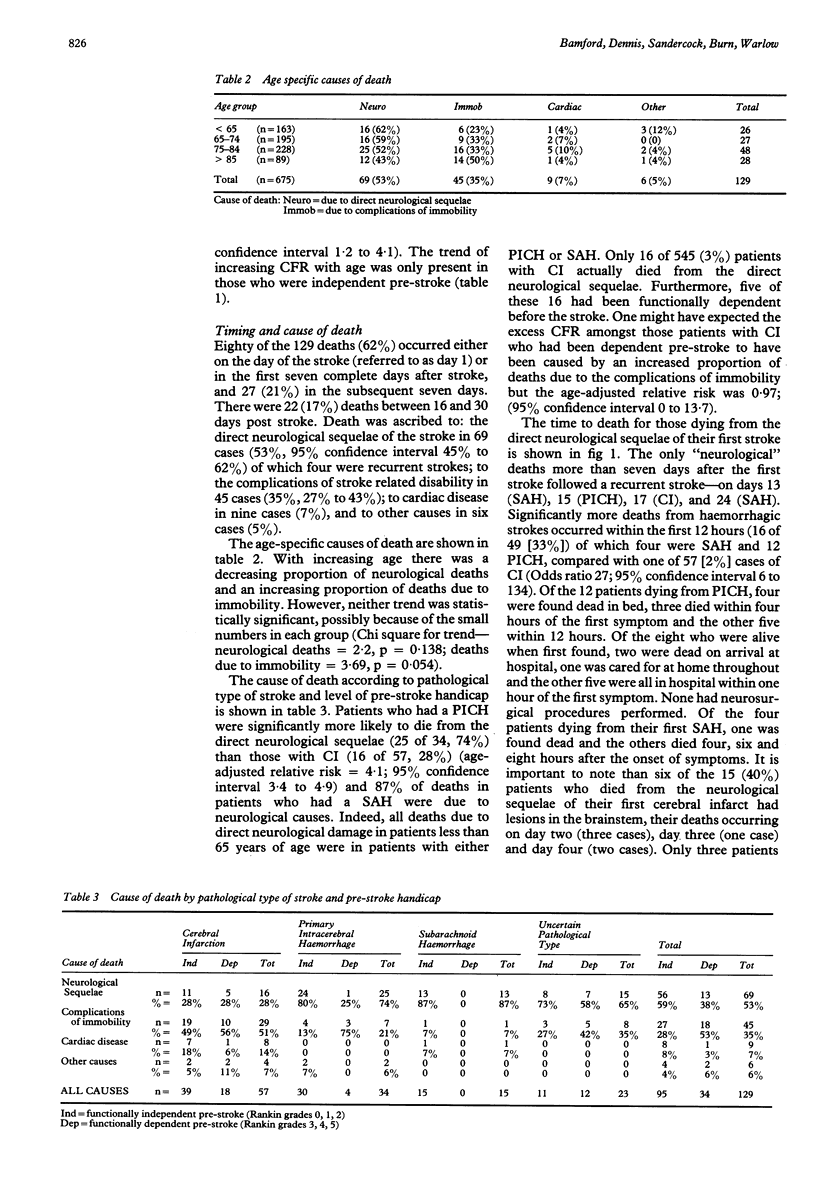
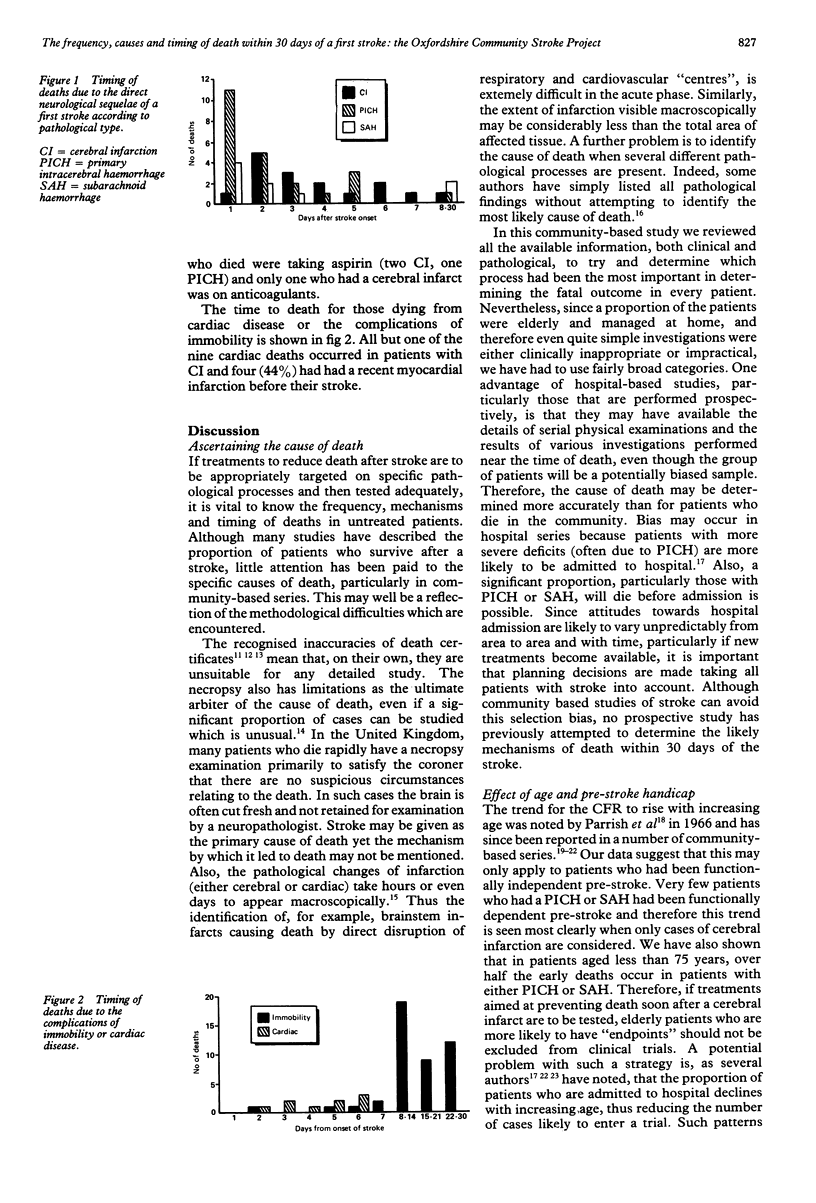
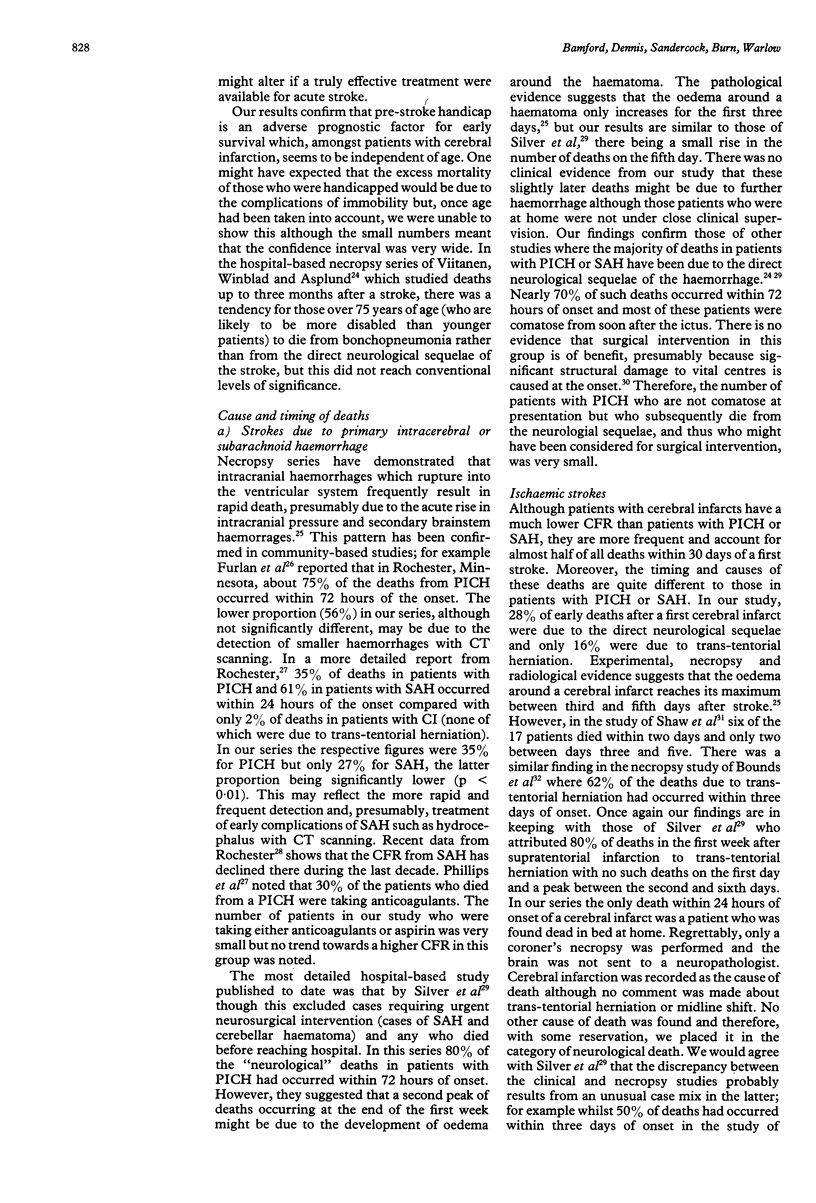
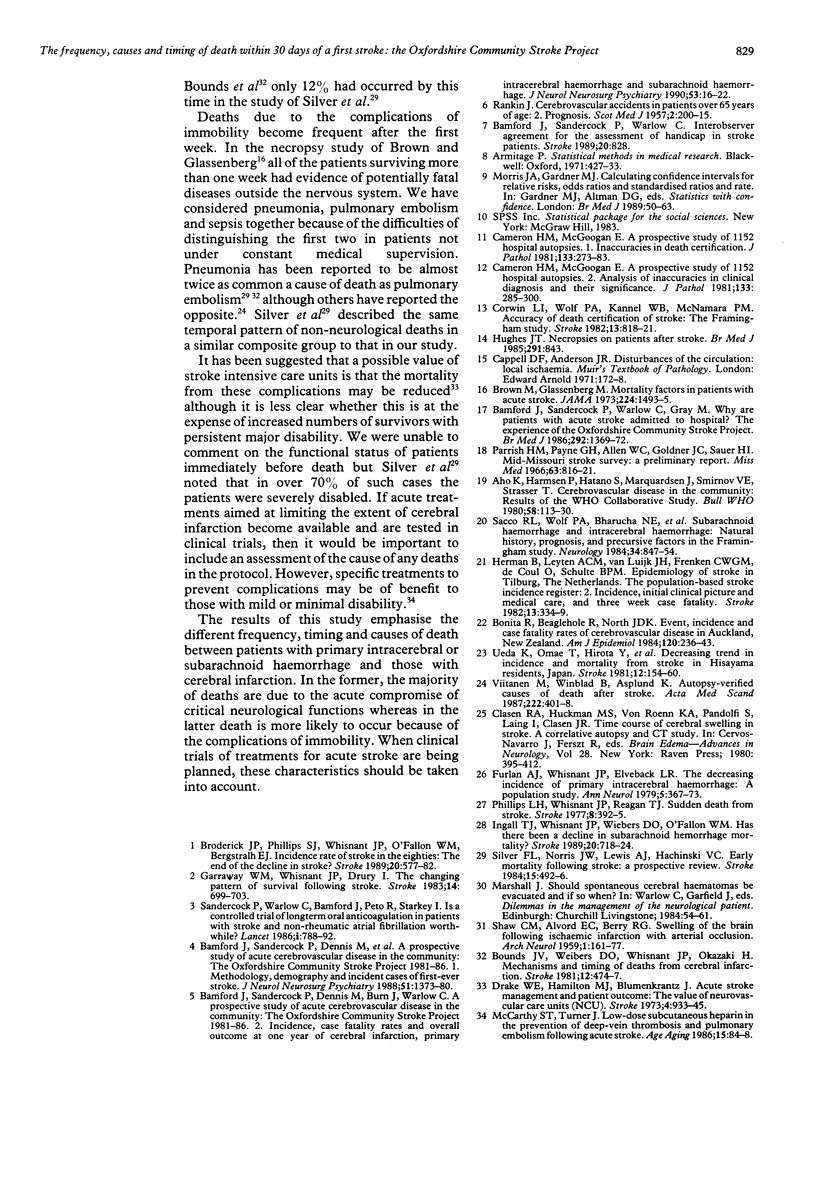
Selected References
These references are in PubMed. This may not be the complete list of references from this article.
- Bamford J. M., Sandercock P. A., Warlow C. P., Slattery J. Interobserver agreement for the assessment of handicap in stroke patients. Stroke. 1989 Jun;20(6):828–828. doi: 10.1161/01.str.20.6.828. [DOI] [PubMed] [Google Scholar]
- Bamford J., Sandercock P., Dennis M., Burn J., Warlow C. A prospective study of acute cerebrovascular disease in the community: the Oxfordshire Community Stroke Project--1981-86. 2. Incidence, case fatality rates and overall outcome at one year of cerebral infarction, primary intracerebral and subarachnoid haemorrhage. J Neurol Neurosurg Psychiatry. 1990 Jan;53(1):16–22. doi: 10.1136/jnnp.53.1.16. [DOI] [PMC free article] [PubMed] [Google Scholar]
- Bamford J., Sandercock P., Dennis M., Warlow C., Jones L., McPherson K., Vessey M., Fowler G., Molyneux A., Hughes T. A prospective study of acute cerebrovascular disease in the community: the Oxfordshire Community Stroke Project 1981-86. 1. Methodology, demography and incident cases of first-ever stroke. J Neurol Neurosurg Psychiatry. 1988 Nov;51(11):1373–1380. doi: 10.1136/jnnp.51.11.1373. [DOI] [PMC free article] [PubMed] [Google Scholar]
- Bamford J., Sandercock P., Warlow C., Gray M. Why are patients with acute stroke admitted to hospital? Br Med J (Clin Res Ed) 1986 May 24;292(6532):1369–1372. doi: 10.1136/bmj.292.6532.1369. [DOI] [PMC free article] [PubMed] [Google Scholar]
- Bonita R., Beaglehole R., North J. D. Event, incidence and case fatality rates of cerebrovascular disease in Auckland, New Zealand. Am J Epidemiol. 1984 Aug;120(2):236–243. doi: 10.1093/oxfordjournals.aje.a113885. [DOI] [PubMed] [Google Scholar]
- Bounds J. V., Wiebers D. O., Whisnant J. P., Okazaki H. Mechanisms and timing of deaths from cerebral infarction. Stroke. 1981 Jul-Aug;12(4):474–477. doi: 10.1161/01.str.12.4.474. [DOI] [PubMed] [Google Scholar]
- Broderick J. P., Phillips S. J., Whisnant J. P., O'Fallon W. M., Bergstralh E. J. Incidence rates of stroke in the eighties: the end of the decline in stroke? Stroke. 1989 May;20(5):577–582. doi: 10.1161/01.str.20.5.577. [DOI] [PubMed] [Google Scholar]
- Brown M., Glassenberg M. Mortality factors in patients with acute stroke. JAMA. 1973 Jun 11;224(11):1493–1495. [PubMed] [Google Scholar]
- Cameron H. M., McGoogan E. A prospective study of 1152 hospital autopsies: I. Inaccuracies in death certification. J Pathol. 1981 Apr;133(4):273–283. doi: 10.1002/path.1711330402. [DOI] [PubMed] [Google Scholar]
- Cameron H. M., McGoogan E. A prospective study of 1152 hospital autopsies: II. Analysis of inaccuracies in clinical diagnoses and their significance. J Pathol. 1981 Apr;133(4):285–300. doi: 10.1002/path.1711330403. [DOI] [PubMed] [Google Scholar]
- Clasen R. A., Huckman M. S., Von Roenn K. A., Pandolfi S., Laing I., Clasen J. R. Time course of cerebral swelling in stroke: a correlative autopsy and CT study. Adv Neurol. 1980;28:395–412. [PubMed] [Google Scholar]
- Corwin L. E., Wolf P. A., Kannel W. B., McNamara P. M. Accuracy of death certification of stroke: the Framingham Study. Stroke. 1982 Nov-Dec;13(6):818–821. doi: 10.1161/01.str.13.6.818. [DOI] [PubMed] [Google Scholar]
- Drake W. E., Jr, Hamilton M. J., Carlsson M., Blumenkrantz J. Acute stroke management and patient outcome: the value of Neurovascular Care Units (NCU). Stroke. 1973 Nov-Dec;4(6):933–945. doi: 10.1161/01.str.4.6.933. [DOI] [PubMed] [Google Scholar]
- Furlan A. J., Whisnant J. P., Elveback L. R. The decreasing incidence of primary intracerebral hemorrhage: a population study. Ann Neurol. 1979 Apr;5(4):367–373. doi: 10.1002/ana.410050410. [DOI] [PubMed] [Google Scholar]
- Garraway W. M., Whisnant J. P., Drury I. The changing pattern of survival following stroke. Stroke. 1983 Sep-Oct;14(5):699–703. doi: 10.1161/01.str.14.5.699. [DOI] [PubMed] [Google Scholar]
- Herman B., Leyten A. C., van Luijk J. H., Frenken C. W., Op de Coul A. A., Schulte B. P. An evaluation of risk factors for stroke in a Dutch community. Stroke. 1982 May-Jun;13(3):334–339. doi: 10.1161/01.str.13.3.334. [DOI] [PubMed] [Google Scholar]
- Hughes J. T. Necropsies on patients after stroke. Br Med J (Clin Res Ed) 1985 Sep 28;291(6499):843–843. doi: 10.1136/bmj.291.6499.843. [DOI] [PMC free article] [PubMed] [Google Scholar]
- Ingall T. J., Whisnant J. P., Wiebers D. O., O'Fallon W. M. Has there been a decline in subarachnoid hemorrhage mortality? Stroke. 1989 Jun;20(6):718–724. doi: 10.1161/01.str.20.6.718. [DOI] [PubMed] [Google Scholar]
- McCarthy S. T., Turner J. Low-dose subcutaneous heparin in the prevention of deep-vein thrombosis and pulmonary emboli following acute stroke. Age Ageing. 1986 Mar;15(2):84–88. doi: 10.1093/ageing/15.2.84. [DOI] [PubMed] [Google Scholar]
- Parrish H. M., Payne G. H., Allen W. C., Goldner J. C., Sauer H. I. Mid-Missouri stroke survey: a preliminary report. Mo Med. 1966 Oct;63(10):816–passim. [PubMed] [Google Scholar]
- Phillips L. H., Whisnant J. P., Reagan T. J. Sudden death from stroke. Stroke. 1977 May-Jun;8(3):392–395. doi: 10.1161/01.str.8.3.392. [DOI] [PubMed] [Google Scholar]
- RANKIN J. Cerebral vascular accidents in patients over the age of 60. II. Prognosis. Scott Med J. 1957 May;2(5):200–215. doi: 10.1177/003693305700200504. [DOI] [PubMed] [Google Scholar]
- SHAW C. M., ALVORD E. C., Jr, BERRY R. G. Swelling of the brain following ischemic infarction with arterial occlusion. Arch Neurol. 1959 Aug;1:161–177. doi: 10.1001/archneur.1959.03840020035006. [DOI] [PubMed] [Google Scholar]
- Sacco R. L., Wolf P. A., Bharucha N. E., Meeks S. L., Kannel W. B., Charette L. J., McNamara P. M., Palmer E. P., D'Agostino R. Subarachnoid and intracerebral hemorrhage: natural history, prognosis, and precursive factors in the Framingham Study. Neurology. 1984 Jul;34(7):847–854. doi: 10.1212/wnl.34.7.847. [DOI] [PubMed] [Google Scholar]
- Sandercock P., Warlow C., Bamford J., Peto R., Starkey I. Is a controlled trial of long-term oral anticoagulants in patients with stroke and non-rheumatic atrial fibrillation worthwhile? Lancet. 1986 Apr 5;1(8484):788–792. doi: 10.1016/s0140-6736(86)91794-0. [DOI] [PubMed] [Google Scholar]
- Silver F. L., Norris J. W., Lewis A. J., Hachinski V. C. Early mortality following stroke: a prospective review. Stroke. 1984 May-Jun;15(3):492–496. doi: 10.1161/01.str.15.3.492. [DOI] [PubMed] [Google Scholar]
- Ueda K., Omae T., Hirota Y., Takeshita M., Katsuki S., Tanaka K., Enjoji M. Decreasing trend in incidence and mortality from stroke in Hisayama residents, Japan. Stroke. 1981 Mar-Apr;12(2):154–160. doi: 10.1161/01.str.12.2.154. [DOI] [PubMed] [Google Scholar]
- Viitanen M., Winblad B., Asplund K. Autopsy-verified causes of death after stroke. Acta Med Scand. 1987;222(5):401–408. doi: 10.1111/j.0954-6820.1987.tb10956.x. [DOI] [PubMed] [Google Scholar]


